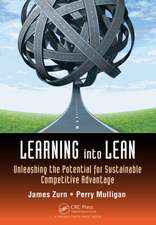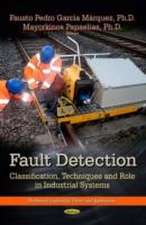Mechanical Tolerance Stackup and Analysis: Mechanical Engineering
Autor Bryan R. Fischeren Limba Engleză Hardback – 26 apr 2011
Often overlooked and misunderstood, tolerance analysis is a critical part of improving products and their design processes. Because all manufactured products are subject to variation, it is crucial that designers predict and understand how these changes can affect form, fit, and function of parts and assemblies—and then communicate their findings effectively.
Written by one of the developers of ASME Y14.5 and other geometric dimension and tolerancing (GD&T) standards, Mechanical Tolerance Stackup and Analysis, Second Edition offers an overview of techniques used to assess and convey the cumulative effects of variation on the geometric relationship between part and assembly features. The book focuses on some key components: it explains often misunderstood sources of variation and how they contribute to this deviation in assembled products, as well as how to model that variation in a useful manner.
New to the Second Edition:
- Explores ISO and ASME GD&T standards—including their similarities and differences
- Covers new concepts and content found in ASME Y14.5-2009 standard
- Introduces six-sigma quality and tolerance analysis concepts
- Revamps figures throughout
With added application examples and features, this comprehensive volume will help design engineers enhance product development and safety, ensuring that parts and assemblies carry out their intended functions. It will also help manufacturing, inspection, assembly, and service personnel troubleshoot designs, verify that in-process steps meet objectives, and find ways to improve performance and reduce costs.
Din seria Mechanical Engineering
- 9%
 Preț: 906.98 lei
Preț: 906.98 lei - 9%
 Preț: 652.87 lei
Preț: 652.87 lei - 9%
 Preț: 1529.94 lei
Preț: 1529.94 lei - 15%
 Preț: 462.37 lei
Preț: 462.37 lei - 20%
 Preț: 503.33 lei
Preț: 503.33 lei - 18%
 Preț: 1942.61 lei
Preț: 1942.61 lei - 18%
 Preț: 1556.66 lei
Preț: 1556.66 lei - 18%
 Preț: 2363.55 lei
Preț: 2363.55 lei - 18%
 Preț: 733.36 lei
Preț: 733.36 lei - 15%
 Preț: 698.32 lei
Preț: 698.32 lei - 18%
 Preț: 899.92 lei
Preț: 899.92 lei - 18%
 Preț: 1133.77 lei
Preț: 1133.77 lei - 26%
 Preț: 1579.61 lei
Preț: 1579.61 lei - 18%
 Preț: 1413.01 lei
Preț: 1413.01 lei - 18%
 Preț: 1009.21 lei
Preț: 1009.21 lei - 18%
 Preț: 891.36 lei
Preț: 891.36 lei - 18%
 Preț: 1223.61 lei
Preț: 1223.61 lei - 18%
 Preț: 808.50 lei
Preț: 808.50 lei - 29%
 Preț: 1406.88 lei
Preț: 1406.88 lei - 15%
 Preț: 508.88 lei
Preț: 508.88 lei - 12%
 Preț: 297.35 lei
Preț: 297.35 lei - 15%
 Preț: 489.26 lei
Preț: 489.26 lei -
 Preț: 374.59 lei
Preț: 374.59 lei - 15%
 Preț: 607.80 lei
Preț: 607.80 lei - 15%
 Preț: 501.05 lei
Preț: 501.05 lei - 18%
 Preț: 907.16 lei
Preț: 907.16 lei - 18%
 Preț: 1283.60 lei
Preț: 1283.60 lei - 30%
 Preț: 857.94 lei
Preț: 857.94 lei - 18%
 Preț: 2370.51 lei
Preț: 2370.51 lei - 18%
 Preț: 1303.34 lei
Preț: 1303.34 lei - 15%
 Preț: 494.20 lei
Preț: 494.20 lei - 18%
 Preț: 1800.94 lei
Preț: 1800.94 lei - 30%
 Preț: 1972.93 lei
Preț: 1972.93 lei - 18%
 Preț: 1401.97 lei
Preț: 1401.97 lei - 18%
 Preț: 893.14 lei
Preț: 893.14 lei - 18%
 Preț: 1941.49 lei
Preț: 1941.49 lei - 29%
 Preț: 1191.13 lei
Preț: 1191.13 lei - 18%
 Preț: 1031.13 lei
Preț: 1031.13 lei - 18%
 Preț: 720.49 lei
Preț: 720.49 lei - 18%
 Preț: 956.88 lei
Preț: 956.88 lei - 15%
 Preț: 463.53 lei
Preț: 463.53 lei - 18%
 Preț: 1679.73 lei
Preț: 1679.73 lei - 18%
 Preț: 1937.66 lei
Preț: 1937.66 lei - 29%
 Preț: 1189.51 lei
Preț: 1189.51 lei - 28%
 Preț: 1580.34 lei
Preț: 1580.34 lei
Preț: 993.85 lei
Preț vechi: 1370.63 lei
-27% Nou
Puncte Express: 1491
Preț estimativ în valută:
190.18€ • 203.36$ • 158.56£
190.18€ • 203.36$ • 158.56£
Carte tipărită la comandă
Livrare economică 17 aprilie-01 mai
Preluare comenzi: 021 569.72.76
Specificații
ISBN-13: 9781439815724
ISBN-10: 1439815720
Pagini: 512
Ilustrații: 350 black & white illustrations, 1 black & white tables
Dimensiuni: 152 x 229 x 33 mm
Greutate: 0.84 kg
Ediția:Revizuită
Editura: CRC Press
Colecția CRC Press
Seria Mechanical Engineering
ISBN-10: 1439815720
Pagini: 512
Ilustrații: 350 black & white illustrations, 1 black & white tables
Dimensiuni: 152 x 229 x 33 mm
Greutate: 0.84 kg
Ediția:Revizuită
Editura: CRC Press
Colecția CRC Press
Seria Mechanical Engineering
Public țintă
Professional Practice & DevelopmentCuprins
Background. Dimensioning and Tolerancing. Tolerance Format and Decimal Places. Converting Plus/Minus Dimensions and Tolerances into Equal Bilaterally Toleranced Dimensions. Variation and Sources of Variation. Tolerance Analysis. Worst-case Tolerance Stackups. Statistical Tolerance Stackups. Geometric Dimensioning and Tolerancing (GD&T). Converting Plus/Minus Tolerancing to Positional Tolerancing and Projected Tolerance Zones. Diametral and Radial Tolerance Stackups. Specifying Material Condition Modifiers and Their Effect on Tolerance Stackups. The Tolerance Stackup Sketch. The Tolerance Stackup Report Form. Tolerance Stackup Direction and Tolerance Stackups with Trigonometry. Putting it All Together: Tolerance Stackups with GD&T Solved Using the Advanced Dimensional Management Method. Calculating Component Tolerances Given a Final Assembly Tolerance Requirement. Floating-Fastener and Fixed-Fastener Formulas and Considerations. Fit Classifications. Form Tolerances in Tolerance Stackups. 3D Tolerance Analysis, 3D Tolerance Analysis Software, and Introduction to Six Sigma Concepts.
Notă biografică
Bryan R. Fischer is owner of Advanced Dimensional Management LLC, which provides consulting and training in GD&T, tolerance analysis, dimensional management, 3D model-based engineering, and related fields, including 3D MBD and MBE, product documentation quality, and engineering standards. Mr. Fischer is recognized as a leading expert with more than 25 years of industrial experience in these areas. Having worked as a GD&T expert, tolerance analyst, dimensional management engineer, and design lead, he has also been a designer, checker, design drafter, and CAD systems programmer, as well as a trainer and consultant in the areas of GD&T, drawing quality, dimensional management and tolerance analysis. He trains and consults in many industries, both commercial and government, with companies ranging from very small to the largest multi-national corporations. He has consulted with inspection and CAD software developers to help them improve their implementations of GD&T, 3D PMI, and model-based product definition practices. He also works with companies around the world helping them to understand and implement 3D model-based product definition and model-based enterprise methods. Bryan has been active in the area of corporate, national, and international standards development and standards management throughout his career, and a longtime member of several standards development committees. He is a member of the American Society of Mechanical Engineers (ASME), the American Society for Quality, and SAE International. He is also an ASME Certified Senior Level GD&T Professional.
Recenzii
Praise for the First Edition
Written by one of the foremost authorities in the field, this reference presents proven and useful methods for determining whether selected dimensioning and tolerancing schemes will yield functional parts and assemblies. It also tells the most practical procedure to communicate the results.
—Mechanical Engineering, Vol. 126, No. 11, Nov. 2004
Written by one of the foremost authorities in the field, this reference presents proven and useful methods for determining whether selected dimensioning and tolerancing schemes will yield functional parts and assemblies. It also tells the most practical procedure to communicate the results.
—Mechanical Engineering, Vol. 126, No. 11, Nov. 2004
Descriere
Written by one of the foremost authorities in the field, this newly revised reference presents the necessary background and proven step-by-step procedures for solving both simple and complex tolerance analysis problems. Using the techniques described in this text, design engineers can ensure that parts and assemblies will satisfy their intended functions. In addition, manufacturing, inspection, assembly, and service personnel can use the methods discussed to troubleshoot designs, verify in-process steps will meet objectives, and find ways to improve performance and reduce costs. This new edition includes many updates and improvements to provide a clearer, easy-to-understand, comprehensive volume.




















